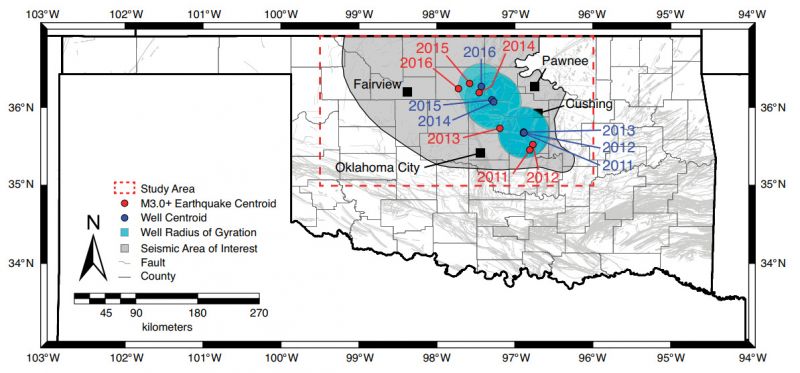To Cut the Number of Bigger Earthquakes, Inject Less Saltwater
Published on by Water Network Research, Official research team of The Water Network in Academic
In Oklahoma, reducing the amount of saltwater (highly brackish water produced during oil and gas recovery) pumped into the ground seems to be decreasing the number of small fluid-triggered earthquakes. But a new study shows why it wasn't enough to ease bigger earthquakes.
The study, led by Ryan M. Pollyea of Virginia Tech in Blacksburg, Virginia, was published online ahead of print in Geology this week.

Figure 2 from Pollyea et al., Annual geographic centroid locations for the years 2011–2016 (the underlying fault map is by Marsh and Holland, 2016), including volume-weighted well centroids, the 1σ radius of gyration, and M3+ earthquake centroids.
Starting around 2009, saltwater disposal (SWD) volume began increasing dramatically as unconventional oil and gas production increased rapidly throughout Oklahoma. As a result, the number of magnitude 3-plus earthquakes rattling the state has jumped from about one per year before 2011 to more than 900 in 2015. "Fluids are basically lubricating existing faults," Pollyea explains. Oklahoma is now the most seismically active state in the lower 48 United States.
Previous studies linked Oklahoma SWD wells and seismic activity in time. Instead, Pollyea and colleagues studied that correlation in space, analyzing earthquake epicenters and SWD well locations. The team focused on the Arbuckle Group, a porous geologic formation in north-central Oklahoma used extensively for saltwater disposal. The earthquakes originate in the basement rock directly below the Arbuckle, at a depth of 4 to 8 kilometers.
The correlation was clear: “When we plotted the average annual well locations and earthquake epicenters, they moved together in space,” says Pollyea. The researchers also found that SWD volume and earthquake occurrence are spatially correlated up to 125 km. That's the distance within which there seems to be a connection between injection volume, fluid movement, and earthquake occurrence.
Read full article: The Geological Society of America
FEATURED ARTICLE
Geospatial analysis of Oklahoma (USA) earthquakes (2011–2016): Quantifying the limits of regional-scale earthquake mitigation measures
Authors: Ryan M. Pollyea (Virginia Tech; ); Neda Mohammadi; John E. Taylor; Martin C. Chapman. 10.1130/G39945.1
Media
Taxonomy
- Oil & Gas
- Geology
- Hydrogeology
- Well Drilling
- Drilling
- Earthquake Insurance